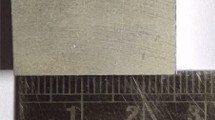Abstract
The machine learning methodology is gaining immense exposure as a potential methodology for solving and modelling the machining behaviour of advanced materials. The present paper deals with the application of machining learning approach in analyzing and predicting the effect of reinforced silicon carbide (SiC) particle size on the erosion behaviour of silicon carbide reinforced polymer composites. L27 orthogonal array was designed based on Taguchi’s methodology to execute the experiments. Support vector machine (SVM) and multi-linear regression (MLR) approach were coupled with Taguchi’s methodology to validate obtained optimized response characteristics. These machine learning-based SVM and MLR models are adopted to analyze the absurdity among obtained experimental results and predicted response. Out of 27 experimental runs based on experimental design, 19 experimental runs were selected for training models whereas 08 models were selected for the testing phase. Impingement angle, workpiece reinforcement, standoff distance and slurry pressure were used as input process parameters, whereas material loss was observed as response characteristics. The kernel functions, i.e. Pearson VII based universal kernel (PUK) and radial based function (RBF) kernel were used with machine learning models to obtain the best performing machine learning approach in predicting erosion behaviour of polymer composites.
Similar content being viewed by others
References
Antil P, Singh S, Manna A (2018) SiCp/glass fibers reinforced epoxy composites: wear and erosion behavior. Indian J Eng Mater Sci 25(2):122–130
Singh M, Singh S (2020) Electrochemical discharge machining: fumes generations, properties and biological effects. Int J Adv Manuf Technol 106(1):357–370
Friedrich K, Pei X-Q, Almajid AA (2013) Specific erosive wear rate of neat polymer films and various polymer composites. J Reinf Plast Compos 32(9):631–643
Qian DN, Bao LM, Takatera M, Kemmochi K, Yamanaka A (2010) Fiber-reinforced polymer composite materials with high specific strength and excellent solid particle erosion resistance. Wear 268(3):637–642
Dallaire S (2013) Slurry erosion resistance of boride-based over lays containing boride crystal oriented perpendicularly to the wearing surface. Wear 297:1006–1015
Patnaik A, Satapathy A, Chand N, Barkoula NM, Biswas S (2010) Solid particle erosion wear characteristics of fiber and particulate filled polymer composites: a review. Wear 268:249–263
Harsha AP, Thakre AA (2007) Investigation on solid particle erosion behavior of poly etherimide and its composites. Wear 262:807–818
Tewari US, Harsha AP, Hager AM, Friedrich K (2003) Solid particle erosion of carbon fibre and glass fibre-polymer composites. Compos Sci Technol 63:549–557
Drensky GA, Hamed AW, Tabakoff WJ, Abot J (2011) Experimental investigation of polymer matrix reinforced composite erosion characteristics. Wear 270:146–151
Pool KV, Dharan CKH, Finnie I (1986) Erosive wear of composite-materials. Wear 107(1):1–12
Tsuda K, Kubouchi M, Sakai T, Saputra AH, Mitomo N (2006) General method for predicting the sand erosion rate of GFRP. Wear 260:1045–1052
Dundar M, Intal OT, Stringer J (1999) The effect of particle size on the erosion of a ductile material at the low particle size limit. Wear 233–235:727–736
Miyazaki N, Hamao T (1996) Effect of interfacial strength on erosion behavior of FRPs. J Compos Mater 30(1):35–50
Rajesh JJ, Bijwe J, Venkataraman B, Tewari US (2004) Effect of impinging velocity on the erosive wear behaviour of polyamides. Tribol Int 37:219–226
Manohar M, Selvaraj T, Sivakumar D (2014) Application of experimental design and analysis of mathematical models for turning inconel 718 using coated carbide tools. Exp Tech 38:61–71
Arindam M, Das P, Majumder A, Debnath M (2014) An approach to optimize the EDM process parameters using desirability-based multi-objective PSO. Production & Manufacturing Research 2:228–240
Antil P, Singh S, Manna A (2018) Genetic algorithm based optimization of ECDM process for polymer matrix composite. Mater Sci Forum 928:144–149
Antil P, Singh S, Manna A (2017) Electrochemical discharge drilling of SiC reinforced polymer matrix composite using Taguchi’s Grey relational analysis, Arabian Journal for Science and Engineering, Springer, 43 (3), pp 1257–1266
Aich U, Banerjee S (2014) Modeling of EDM responses by support vector machine regression with parameters selected by particle swarm optimization. Appl Math Model 38(11–12):2800–2818
Guangwei H, Weiwen X, Ling Q, Wansheng Z (2018) Online workpiece height estimation for reciprocated traveling wire EDM based on support vector machine. Procedia CIRP 68:126–131
Wang G, Qian L, Guo Z (2013) Continuous tool wear prediction based on Gaussian mixture regression model. Int J Adv Manuf Technol 66:1921
Sun J, Rahman M, Wong YS, Hong GS (2004) Multi classification of tool wear with support vector machine by manufacturing loss consideration. Int J Mach Tools Manuf 44(11):1179–1187
Antil P, Singh S, Singh P (2018) Taguchi’s methodology based parametric analysis of material removal rate during ECDM of PMCs. Procedia Manuf 26:469–473
Antil P (2018) Experimental analysis on wear behavior of PMCs reinforced with electroless coated silicon carbide particulates. Silicon 11(4):1791–1800
Singh M, Singh S (2019) micro-machining and process optimization of electrochemical discharge machining (ecdm) process by topsis method, Advances in Manufacturing II. Lecture Notes in Mechanical Engineering, pp 206–215
Vapnik V (1995) The nature of statistical learning theory. Springer, New York
Corinna C, Vapnik V (1995) Support vector networks. Mach Learn 20(3):273–297
Smola A, Murata N, Scholkopf B, Muller KR (1998) A symptotically optimal choice of ε-loss for support vector machines. Proceedings of the international conference on artificial neural networks, perspectives in neural computing, pp 105–110, Berlin, Springer
Vapnik V (1999) Three remarks on the support vector method of function estimation. Advances in Kernel Methods—Support Vector Learning, MIT Press, Cambridge, pp 25–42
Ustun B, Melssen WJ, Buydens LM (2006) Facilitating the application of support vector regression by using a universal Pearson VII function based kernel. Chemom Intell Lab Syst 81(1):29–40
Author information
Authors and Affiliations
Corresponding author
Additional information
Publisher’s Note
Springer Nature remains neutral with regard to jurisdictional claims in published maps and institutional affiliations.
Rights and permissions
About this article
Cite this article
Kharb, S.S., Antil, P., Singh, S. et al. Machine Learning-Based Erosion Behavior of Silicon Carbide Reinforced Polymer Composites. Silicon 13, 1113–1119 (2021). https://doi.org/10.1007/s12633-020-00497-z
Received:
Accepted:
Published:
Issue Date:
DOI: https://doi.org/10.1007/s12633-020-00497-z




